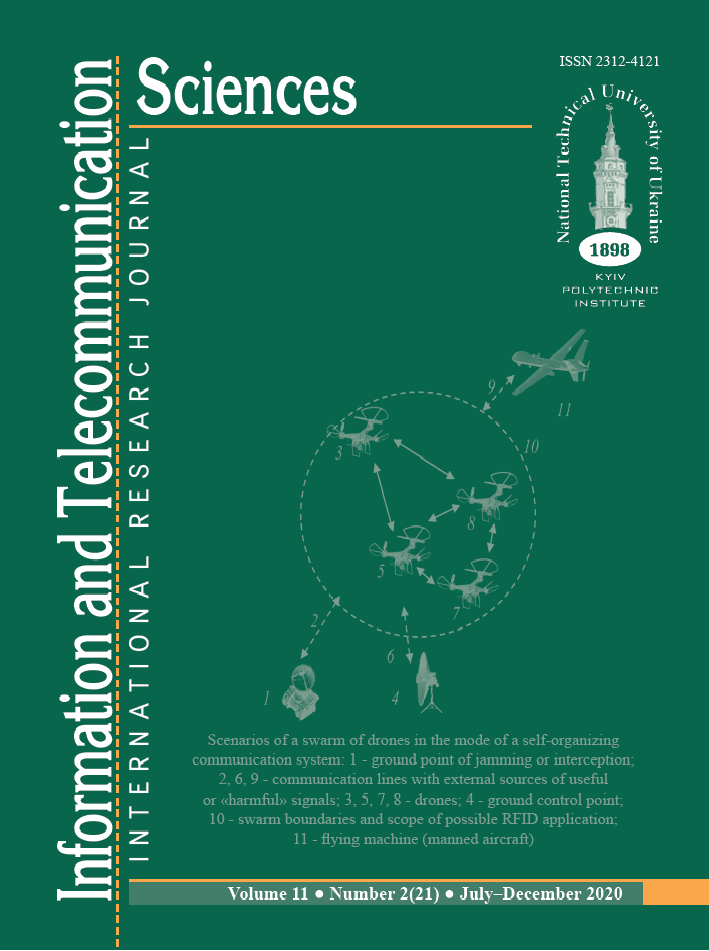NOISE RESISTANCE OF REMOTE AUTHENTICATION VIA LTE NETWORK
DOI:
https://doi.org/10.20535/2411-2976.22020.38-43Keywords:
remote authentication, LTE, noise resistance, biometric template, stegosystemAbstract
Background. LTE networks support a wide range of applications and services. These networks provide high-quality mobile services and have increased transmission rates and often used for remote biometric authentication, but the influence of noise and fading in wireless channels on quality and stability of biometric authentication is not analyzed yet.
Objective. The aim of the paper is to study the model of the physical layer of the LTE network, which transmits biometric templates for authentication.
Methods. We use computer simulation of biometric authentication system for preparing biometric template and Matlab models of wireless communication channel using the LTE technology for analysis of influence of noise and fading on channel.
Results. The paper presents the results of the evaluation of the authentication system under the influence of interference in communication channels. The impact of the use of MIMO technology on the dependence of the number of bit errors is evaluated. The obtained results show that in order to improve the quality of remote biometric authentication systems, it is advisable to use additional means of noise immunity and the use of adaptive settings on the transmitter side.
Conclusions. The system of remote biometric authentication with data transmission via LTE network was modeled. Influence of AWGS and Doppler shifts in wireless communication channels was analyzed. For noise resistance different error correction codes are implemented.
References
Ivanenko S.A., Bezruk V.M. Planning and optimization of
networks 4G // 23 Int. Crimean Conference “Microwave &
Telecommunication Technology” (CriMiCo’2013) John
Wiley & Sons, Inc. – 2014. – pp.500-501.
. Liashenko G., Astrakhantsev A. Аnalysis of biometric
authentication techniques // Information processing systems,
Kharkov – 2017. Vol.2, No. 147. – pp.111-114.
Shcherbak A., Astrakhantsev A., Shcherbak O., Liashenko
G. Analysis of stealth and noise resistance of network
steganography methods (Ukrainian) // scientific journal
Problems of Telecommunications. – 2020. Vol.2, No.23. –
pp.89-98.
Saaty T., Decision making with the analytic hierarchy
process // International Journal of Services Sciences, vol. 1,
no. 1, pp. 83-98, 2008.
Liashenko G., Astrakhantsev A. and Chernikova V.,
Network steganography application for remote biometrie user
authentication // 2018 IEEE 9th International Conference on
Dependable Systems Services and Technologies
(DESSERT), pp. 326-330, 2018.
Maltoni D., Cappelli R. Fingerprint Recognition //
Handbook of Biometrics. Springer, Boston, MA, 2008 –pp.
-42.– DOI:10.1007/978-0-387-71041-9_2.
Mazurczyk W., Smolarczyk M. and Szczypiorski K.
Retransmission steganography and its detection // Soft
Computing Journal, Springer, no. 500, November 2009.
Cauich E., Gömez R. and Watanabe R. Data Hiding in
Identification and Offset IP Fields // Proceedings of 5th
International School and Symposium of Advanced
Distributed Systems (ISSADS) 2005, pp. 118-125, 2005.
Frączek W., Mazurczyk W. and Szczypiorski K. Hiding
information in a Stream Control Transmission Protocol //
Computer Communications, vol. 35, no. 2, pp. 159-169,
Mazurczyk W., Szaga P. and Szczypiorski K. Using
transcoding for hidden communication in IP telephony //
Multimedia Tools and Applications, vol. 70, no. 3, pp. 2139-
, June 2014.
Budigere Karthik, Panchakarla Nagasai, Chemmagate
Binoy, Roy Shourov LTE: Long Term Evolution of 3GPP
Riyadh Khlf Ahmed, Doppler fading communication
channel performance simulation // International journal of
physical sciences. – 2017. – Vol.12, No. 7. – pp.89-94.
Downloads
Published
How to Cite
Issue
Section
License
The ownership of copyright remains with the Authors.
Authors may use their own material in other publications provided that the Journal is acknowledged as the original place of publication and National Technical University of Ukraine “Igor Sikorsky Kyiv Polytechnic Institute” as the Publisher.
ITS articles are published under Creative Commons licence:
- Authors retain copyright and grant the journal right of first publication with the work simultaneously licensed under CC BY 4.0that allows others to share the work with an acknowledgement of the work's authorship and initial publication in this journal.
- Authors are able to enter into separate, additional contractual arrangements for the non-exclusive distribution of the journal's published version of the work (e.g., post it to an institutional repository or publish it in a book), with an acknowledgement of its initial publication in this journal.
- Authors are permitted and encouraged to post their work online (e.g., in institutional repositories or on their website) prior to and during the submission process, as it can lead to productive exchanges, as well as earlier and greater citation of published work.

